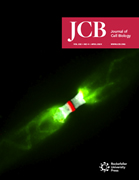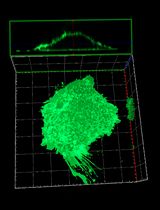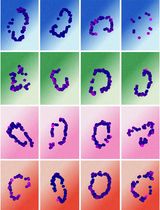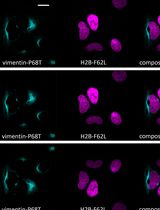- EN - English
- CN - 中文
Calibrating Fluorescence Microscopy With 3D-Speckler (3D Fluorescence Speckle Analyzer)
使用3D-Speckler校准荧光显微镜(3D荧光散斑分析仪)
发布: 2024年08月20日第14卷第16期 DOI: 10.21769/BioProtoc.5051 浏览次数: 1544
评审: Keisuke TabataIvonne SehringAnonymous reviewer(s)
Abstract
Fluorescence microscopy has been widely accessible and indispensable in cell biology research. This technique enables researchers to label targets, ranging from individual entities to multiple groups, with fluorescent markers. It offers precise determinations of localization, size, and shape, along with accurate quantifications of fluorescence signal intensities. Furthermore, an ideal fluorescence microscope can achieve approximately 250 nm in lateral and 600 nm in axial resolution. Despite its integral role in these measurements, the calibration of fluorescence microscopes is often overlooked. This protocol introduces the use of 3D-Speckler (3D fluorescence speckle analyzer), a semi-automated software tool we have recently developed, for calibrating fluorescence microscopy. Calibration of fluorescence microscopy includes determining resolution limits, validating accuracy in size measurements, evaluating illumination flatness, and determining chromatic aberrations. 3D-Speckler is user-friendly and enables precise quantification of fluorescence puncta, including nanoscale 2D/3D particle size, precise locations, and intensity information. By utilizing multispectral fluorescence beads of known sizes alongside 3D-Speckler, the software can effectively calibrate imaging systems. We emphasize the importance of routine calibration for imaging systems to maintain their integrity and reproducibility, ensuring accurate quantification. This protocol provides a detailed step-by-step guide on using 3D-Speckler to calibrate imaging systems.
Key features
• Semi-automated particle detection
• Accurate three-dimensional measurement of fluorescent particle sizes
• High-precision three-dimensional localization of fluorescent particles
• Precision analysis of point spread function and chromatic aberration in fluorescence microscopy
Keywords: Fluorescence microscopy (荧光显微镜)Background
Fluorescence microscopy serves as an essential tool in a variety of research fields, offering the flexibility to analyze specimens ranging from in vitro to in vivo, with resolutions spanning from micrometers to nanometers [1,2]. An advantage of this technique is the ability to detect individual fluorescent targets and either simultaneously or sequentially visualize multiple fluorescent markers. Applications include the characterization of fluorescently labeled purified proteins, as well as the examination of proteins and genes within 2D/3D cell culture systems, tissues, and whole organisms. Fluorescence microscopy is utilized in various in vitro studies, such as investigating the liquid–liquid phase separation of proteins using fluorescently labeled purified proteins [3,4], examining spindle formation through droplet assays [5], and employing fluorescence resonance energy transfer (FRET) to analyze protein–protein interactions [6] and measure mechanical tension [7,8]. Its utility in developmental biology extends to research across a variety of models, including plants, Drosophila, Xenopus, C. elegans, zebrafish, and mice [9]. Moreover, fluorescence microscopy is a cornerstone in cell biology research, enabling the investigation of cellular processes in organisms from yeast to humans, across both 2D and 3D culture systems, as well as in living and fixed tissue samples [10,11]. This technique allows researchers to accurately determine spatial locations, relative localizations, dimensions, and shapes at the nanoscale. For instance, it has been demonstrated that standard confocal microscopy can achieve <5 nm precision in determining 2D/3D protein architecture within cells using a dual-color fluorescence approach [12,13]. Furthermore, fluorescence microscopy excels in quantifying protein copy numbers and assessing relative protein concentrations with high accuracy [14–16]. The resolution of fluorescence microscopy is constrained by the point spread function (PSF), which represents the 3D diffraction pattern of light emitted from an infinitely small point source [17]. An ideal fluorescence microscope, equipped with a high numerical aperture (NA) objective lens (NA > 1.4) and a high-resolution camera, can achieve resolutions of approximately 250 nm laterally and 600 nm axially [18,19]. However, the maximum resolution is also contingent on the signal-to-noise ratio (SNR) of the specimens. These resolution limits can be enhanced without altering the optical setup through expansion microscopy (ExM), which physically expands specimens without changing the optics setup, or through post-imaging processing techniques, such as deconvolution [18,20,21]. Additionally, ongoing developments in super-resolution microscopy significantly improve resolutions compared to conventional fluorescence microscopes, enabling the further detailed study of nano-scale cellular structures [1,22–24].
All fluorescence microscopes have the potential to achieve their theoretical resolution maximum and quantitative accuracy. However, this potential heavily relies on the components and the conditions under which microscopy is conducted. To understand the current conditions of the imaging system, it is critical to routinely perform calibrations. We have recently developed the 3D-Speckler software, which enables precise quantification of fluorescence puncta in both biological and non-biological samples [18]. Utilizing fluorescence beads of known sizes in conjunction with 3D-Speckler allows for the comprehensive evaluation of resolution limits, size quantification accuracy, chromatic aberration determination, and the flatness of illumination produced by imaging systems. The aim of this article is to present a comprehensive guide on utilizing the 3D-Speckler software for calibrating imaging systems. This guide is intended for a broad audience interested in fluorescence microscopy, rather than experts in optics and mathematics. Consequently, this protocol minimizes the explanation of the coding and mathematical principles behind 3D-Speckler. For detailed information, please refer to our original manuscript [18]. Briefly, 3D-Speckler identifies fluorescence particles primarily based on their relative signal intensities against the background and determines particle sizes through a full-width-at-half-maximum (FWHM) calculation based on a 2D or 3D Gaussian profile fitted to the intensity profile. The intensity measurements for fluorescence beads can be performed either without background correction or with a local background correction for each bead [14]. 3D-Speckler can determine the center of fluorophores with ~2 nm accuracy, which allows it to accurately identify chromatic aberrations, an unavoidable image distortion that occurs between different wavelengths, by measuring the distance between the centers of fluorophores with different wavelengths within a single bead. This process is designed to evaluate their current performance and ensure their integrity, accuracy, and reproducibility in quantification tasks.
Materials and reagents
TetraSpeck Fluorescent Microspheres Size kit (Thermo Fisher Scientific, catalog number: T14792) (see General notes 1–2)
Appropriate immersion medium [oil (e.g., Nikon, Type F), water (Mili-Q water), or silicone (e.g., Nikon, silicone immersion oil)] for the objectives you wish to calibrate
Equipment
Any type of fluorescence microscope (e.g., Nikon, model: Nikon-Ti2)
Example microscope setting: a Nikon Ti-2 inverted microscope equipped with a Yokogawa SoRa-W1 super-resolution spinning-disc confocal installed uniformizer, a high-resolution Hamamatsu Flash V3 CMOS camera, 4-line lasers (405, 488, 561, 640, 100 mW power), and a 60× or a 100× NA 1.4 oil objective
Image analysis PC [e.g., Dell, model: Precision 5820 Tower with Intel Core i7-9800X (3.8 GHz), Windows 10 Pro 64, 64 GB 2666 MHz DDR4, and Radeon Pro WX5100 8 GB]
Software and datasets
MATLAB (MathWorks, R2019-b and above, 10/1/2018, license required) (see General note 3)
3D-Speckler (https://github.com/suzukilabmcardle/3D-Speckler) (see General note 4) (07/20/2024, publicly available)
The source code, bfmatlab, user manual, and example test images are available at the following link: https://drive.google.com/drive/u/3/folders/1jKqiYFm31cJ0VVhGhLFhRuLI_ZiqmRjF (07/20/2024, publicly available)
Microscope control software (example: Nikon NIS Element, 04/05/2018, license required for NIS Element)
Procedure
文章信息
稿件历史记录
提交日期: Apr 9, 2024
接收日期: Jul 4, 2024
在线发布日期: Jul 24, 2024
出版日期: Aug 20, 2024
版权信息
© 2024 The Author(s); This is an open access article under the CC BY license (https://creativecommons.org/licenses/by/4.0/).
如何引用
Readers should cite both the Bio-protocol article and the original research article where this protocol was used:
- Lin, C. and Suzuki, A. (2024). Calibrating Fluorescence Microscopy With 3D-Speckler (3D Fluorescence Speckle Analyzer). Bio-protocol 14(16): e5051. DOI: 10.21769/BioProtoc.5051.
- Loi, J., Qu, X. and Suzuki, A. (2023). Semi-automated 3D fluorescence speckle analyzer (3D-Speckler) for microscope calibration and nanoscale measurement. J Cell Biol. 222(4). https://doi.org/10.1083/jcb.202202078.
分类
细胞生物学 > 细胞成像 > 荧光
生物物理学 > 显微技术
生物信息学与计算生物学
您对这篇实验方法有问题吗?
在此处发布您的问题,我们将邀请本文作者来回答。同时,我们会将您的问题发布到Bio-protocol Exchange,以便寻求社区成员的帮助。
提问指南
+ 问题描述
写下详细的问题描述,包括所有有助于他人回答您问题的信息(例如实验过程、条件和相关图像等)。
Share
Bluesky
X
Copy link












